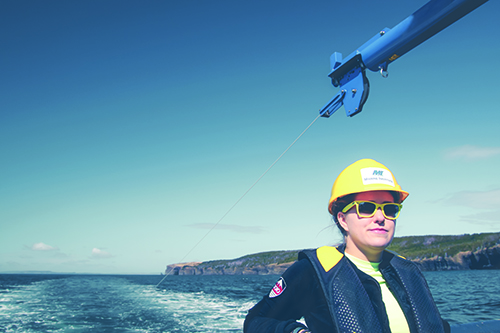News
Tuesday, July 10, 2018
A Marine Institute (MI) alumna is joining an all-female Arctic expedition in August to participate in snorkelling safaris and ocean education programs with Inuit youth and elders in Nunavut and Greenland.
Sarah Walsh is the only Newfoundlander among the Sedna Epic Expedition’s 16-member team of volunteers that hails from other parts of Canada, the U.S. and Mexico.
“It’s such an important project and I’m glad to be part of it – getting out on the water, getting involved with the communities and helping them realize they have a lot more power than they think and they can get a lot done,” she said.
Ms. Walsh jumped at the opportunity to join the Sedna team when the invitation came from expedition founder and team leader, Susan R. Eaton.
“Sarah is a great addition to the team,” said Ms. Eaton, who is also a geologist and geophysicist.
“Sarah’s background in hydrography, science communication and education — she’s done a lot of that during her summer jobs — is important because we do a lot of ocean education mobilization and knowledge-sharing with Inuit communities. Sarah’s got a lot of skill in ocean education.”
Sea women
The team of “sea women” includes a geologist, a remotely operated vehicle instructor, a paramedic, a videographer, a diving instructor and a maritime archaeologist.
Ms. Walsh is a multidisciplinary hydrographer in St. John’s with the Canadian Hydrographic Service.
Last year, she completed MI’s diploma program in ocean mapping and a bachelor of technology and also holds a bachelor of science in marine biology from Memorial University.
To participate in the self-funded expedition, she spent the past few months raising $19,000 through sponsors, fundraising activities and a GoFundMe account.
Disappearing sea ice
The expedition, which takes its name from the sea goddess of Inuit legend, has been documenting climate change and disappearing sea ice in the Arctic since its first voyage in 2014.
This year’s voyage is on board the 137-meter vessel Ocean Endeavour.
One expedition goal is to scout and document the impacts of global warming on sea ice, the Arctic ecosystem and Indigenous Peoples’ traditional way of life.
Another goal is to introduce Inuit girls to the possibilities of ocean-related careers — everything from marine biologists to hydrographers to underwater photographers.
Knowledge sharing
In consultation with Inuit advisors, the Sedna team will visit the Nunavut communities of Resolute and Pond Inlet to deliver experiential ocean education programs. They’ll use mobile aquariums to temporarily display marine life and run workshops on how to build remotely operated vehicles (ROVs).
They’ll also use the Deep Trekker ROV on loan from MI to provide livestream underwater images of what’s happening long the shores of each community.
“I’m really grateful for all the support the Marine Institute has given me and the team,” said Ms. Walsh. “This ROV will really help towards ocean education during the expedition.”
The team will lead Inuit girls and elders on diving and snorkelling safaris in Arctic waters under the supervision of diving masters and using cold-water gear provided by Newfoundland and Labrador-based dive company, Ocean Quest.
“We’ll be exploring around icebergs and ice pans,” said Ms. Walsh. “It’s a way to empower and educate young women in northern communities and to help them understand that they can also change what’s happening to our oceans and they can contribute and be leaders in the Arctic.”
Ocean educator
While a student at MI, Ms. Walsh was selected for a seafloor mapping internship with Ocean Exploration Trust — exploring the sea floor off Mexico’s west coast and educating young people.
The year before, she participated in the Students on Ice Expedition, travelling around the Arctic with students from all over the world, teaching young people about climate change and learning about Inuit culture and traditions. It was her first time in the North.
“I always wanted to travel north and it was something that I was always interested in. Growing up, I wasn’t exposed to Indigenous culture and in school you don’t learn a lot about it, so when I was up there it was really eye-opening.”





